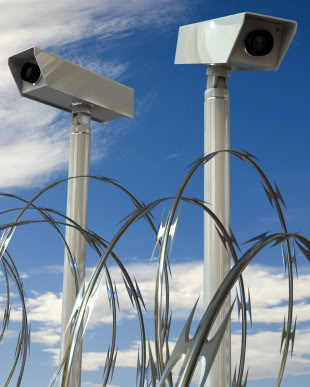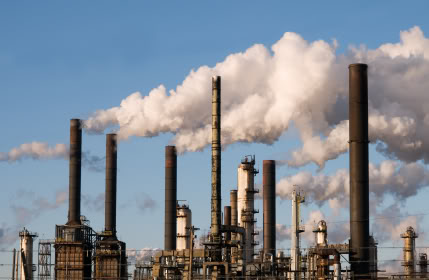More Stringent SO2 NAAQS Finalized by U.S. EPA
U.S. EPA has announced the promulgation of a new 1-hour National Ambient Air Quality Standard (NAAQS) for sulfur dioxide (SO2). The new 1-hour NAAQS level is 75 parts per billion (ppb) measured as the three year average of the 99th percentile daily 1-hour maximum concentration. The new 1-hour NAAQS is a primary standard that replaces the existing annual and 24-hour SO2 NAAQS levels. The NAAQS will become effective in August 2010, at which point any future construction permit applications or applications that are still under state or U.S. EPA review for major new sources or major modifications will need to address compliance with the 1-hour NAAQS level (i.e., there is no “grandfathering” of existing construction permit applications).
 The new NAAQS is extremely restrictive due to the stringency of the NAAQS level and the short-term nature of the standard. The NAAQS level is lower than the recently promulgated 1-hour NO2 NAAQS (75 ppb versus 100 ppb) and is measured in a manner that will capture more peak concentrations (99th percentile versus 98th percentile). In areas that will be in attainment with the new SO2 NAAQS, the new standard will make demonstrating NAAQS compliance for Prevention of Significant Deterioration (PSD) construction permits and Title V renewals extremely difficult where required. Some areas will eventually be designated as nonattainment areas with respect to the new NAAQS, at which point Lowest Achievable Emission Rate (LAER) requirements that have not historically been addressed for SO2 will need to be implemented for major new sources or major modifications. Proactively planning for the impacts of the new NAAQS is critical (see ALL4’s May 2010 4 The Record article for guidance).
The new NAAQS is extremely restrictive due to the stringency of the NAAQS level and the short-term nature of the standard. The NAAQS level is lower than the recently promulgated 1-hour NO2 NAAQS (75 ppb versus 100 ppb) and is measured in a manner that will capture more peak concentrations (99th percentile versus 98th percentile). In areas that will be in attainment with the new SO2 NAAQS, the new standard will make demonstrating NAAQS compliance for Prevention of Significant Deterioration (PSD) construction permits and Title V renewals extremely difficult where required. Some areas will eventually be designated as nonattainment areas with respect to the new NAAQS, at which point Lowest Achievable Emission Rate (LAER) requirements that have not historically been addressed for SO2 will need to be implemented for major new sources or major modifications. Proactively planning for the impacts of the new NAAQS is critical (see ALL4’s May 2010 4 The Record article for guidance).
Stationary Compression and Spark Ignition Internal Combustion Engine Rule Revisions Proposed
On May 21, 2010, U.S. EPA proposed amendments to 40 CFR Part 60, Subparts IIII (Standards of Performance for Stationary Compression Ignition Internal Combustion Engines) and Subpart JJJJ (Standards of Performance for Stationary Spark Ignition Internal Combustion Engines). The proposed rule would make the following changes to the existing Subpart IIII and JJJJ rules:
 Implement more stringent standards for stationary compression ignition engines with displacement greater than or equal to 10 liters per cylinder and less than 30 liters per cylinder consistent with recent revisions to standards for similar mobile source marine engines (Subpart IIII).
Implement more stringent standards for stationary compression ignition engines with displacement greater than or equal to 10 liters per cylinder and less than 30 liters per cylinder consistent with recent revisions to standards for similar mobile source marine engines (Subpart IIII). - Allow owners and operators to develop their own operation and maintenance plans as an alternative to following manufacturer provided operation and maintenance procedures (Subpart IIII). Note: Owners and operators that choose this revised approach to operation and maintenance will generally be subject to additional testing and will be required to keep maintenance plans and records.
- Clarify the applicability of Subparts IIII and JJJJ to the installation and operation of temporary engines (i.e., engines in one (1) location for less than one (1) year) (Subparts IIII and JJJJ).
- Revise the requirements for engines with displacement at or above 30 liters per cylinder to align more closely with recent standards for similar mobile source marine engines, and for engines in rural portions of Alaska that are not accessible by the Federal Aid Highway System (Subpart IIII).
- Add a definition for “reconstruct” that is specific to Subpart IIII and JJJJ.
- Revise the standards of performance for new stationary spark ignition internal combustion engines to mirror certain revisions proposed for compression ignition engines (Subpart JJJJ).
U.S. EPA will accept comments on the proposed amendments to 40 CFR Part 60, Subparts IIII and JJJJ rule until 60 days following the publication of the proposed amendments in the Federal Register.
U.S. EPA Convenes RSL Modelers Workshop
On May 10 – 13, U.S. EPA met with regional, state, and local modelers in Portland, Oregon for the U.S. EPA Regional/State/Local (RSL) Modelers Workshop. Several “hot-topic” items were included on the agenda, most notably, the new NO2 and SO2 National Ambient Air Quality Standards (NAAQS). The regulated community was anticipating that further guidance related to Significant Impact Levels (SILs) for NO2 would be released at the workshop. However, based on ALL4 follow-up discussions with state regulators who attended the workshop, no significant guidance regarding a proposed NO2 SIL was provided by U.S. EPA. It is anticipated that U.S. EPA will release guidance on this in the “near future” on the Support Center for Regulatory Atmospheric Modeling (SCRAM) website (www.epa.gov/ttn/scram/). 
The workshop, which is not open to the public, is held to discuss regulatory air quality modeling issues. However, presentations given at the workshop are made available to the public and can be viewed here.
Widespread Applicability and Energy Assessment Highlight the Proposed New Boiler MACT Rules
As we reported in last month’s 4 The Record, April 29, 2010 was a busy day for U.S. EPA and marked the culmination of years of background effort and planning related to air toxic emissions from boilers. U.S. EPA has proposed four (4) rules that, when finalized, will impact thousands of facilities. Two (2) of these rules are intended to reduce emissions of toxic air pollutants from boilers and process heaters located at both major and area sources of hazardous air pollutant (HAP) emissions (Boiler MACT rules).
Widespread Applicability and New Challenges for Industry
ALL4 recognizes that these proposed new rules will affect almost the entire regulated community and we have assembled an internal RegTech team of experts to analyze the impact that this rulemaking will have on boilers and process heaters everywhere. ALL4’s opinion of the proposed Boiler MACT rules is that they contain some very restrictive emission limitations and onerous monitoring requirements for both existing and new sources. In their present form, the proposed new Boiler MACT rules will present a compliance challenge for many facilities.
New Energy Assessment Requirement
One interesting new feature present in both Boiler MACT rules is the requirement to perform an energy assessment. No other MACT standard requires affected sources to perform an energy assessment; however, we’re not all that surprised to see it in light of where U.S. EPA seems to be heading with their regulatory development process. Most are aware of U.S. EPA’s greenhouse gas (GHG) regulatory activities. The energy assessment requirement appears to bridge the GHG regulations and the MACT standards. Furthermore, one of the first considerations of a climate change GHG reduction strategy or GHG Best Available Control Technology (BACT) analysis is to perform an energy assessment. The energy assessment is a constant theme in these regulatory activities because improved energy efficiency means less fuels burned, and less fuel burned means less criteria pollutants, less HAPs, and less GHG emissions.

There is one difference between the proposed energy assessment requirements for major sources and area sources. Major sources must also develop an energy management program using the ENERGY STAR Guidelines for Energy Management. The ENERGY STAR website indicates that an energy management program must include procedures that are put into place to continually assess and improve energy usage.
With a deadline for comment submittal of only 60 days after publication in the Federal Register (i.e., by August 3, 2010), we encourage you to take part in the public process and submit comments, either through a trade organization or your company.
We’re wrapping up our 4 Part Boiler MACT and CISWI Webinar Series. If you missed out on the series, be sure to check out our presentation slides. Stay tuned for more in-depth updates over the coming months in ALL4’s 4 The Record and 4 The Record Extra.
Final PSD and Title V Greenhouse Gas Tailoring Rule
Final PSD and Title V Greenhouse Gas Tailoring Rule
On May 13, 2010, U.S. EPA issued the final rule known as the Prevention of Significant Deterioration (PSD) and Title V Greenhouse Gas (GHG) Tailoring Rule (a.k.a. the GHG Tailoring Rule). It was subsequently published in the Federal Register on June 3, 2010 (75 FR 31514) and will become effective on August 2, 2010. The GHG Tailoring Rule sets the timing and establishes thresholds for addressing GHG emissions from stationary sources under the Clean Air Act (CAA) permitting programs.
It’s official: CAA permitting requirements for GHGs
In a related action, on April 1, 2010, U.S. EPA finalized the light duty vehicle rule controlling GHG emissions, establishing GHG standards for these vehicles and thus making GHGs “subject to regulation” and triggering CAA permitting requirements for GHGs from stationary sources effective January 2, 2011. The CAA permitting program emission thresholds for criteria pollutants (e.g., lead, sulfur dioxide, and nitrogen dioxide) are 100 and 250 tons per year (tpy). However, these thresholds are not realistic for GHGs which are emitted by numerous sources in much greater quantities, and at these levels tens of thousands of additional PSD permits and millions of additional Title V permits would be required. The PSD and Title V GHG Tailoring Rule “tailors” the existing requirements of the PSD and Title V Operating Permit programs to limit which facilities will be required to obtain PSD and Title V permits related to GHG emissions.
GHG Tailoring Rule Implementation
The new CAA permitting requirements established by the PSD and Title V GHG Tailoring Rule will be implemented in two initial steps which are generally described as follows:
– Step 1 (January 2, 2011 to June 30, 2011)
Only sources currently subject to the PSD program will be subject to permitting program requirements for GHG emissions under PSD, and only if the projects being permitted increase GHG emissions by 75,000 tpy or more on a carbon dioxide equivalent (CO2e) basis. Similarly, only sources currently subject to the Title V Operating Permit program for pollutants other than GHG will become subject to Title V requirements for GHGs.
– Step 2 (July 1, 2011 to June 30, 2013)
Sources with new construction projects that emit GHGs at levels of 100,000 tpy or more, regardless of whether they exceed permitting thresholds for other pollutants, will be subject to PSD requirements. Modifications at existing facilities that increase GHG emissions by at least 75,000 tpy, regardless of other pollutants, will also be covered. Facilities that emit at least 100,000 tpy CO2e will become subject to Title V requirements even if they would not apply based on other regulated pollutants.
 More GHG regulation on the way
More GHG regulation on the way
In this final rule U.S. EPA also commits to undertake a rulemaking beginning in 2011 and concluding no later than July 1, 2012 to consider and possibly establish additional PSD and Title V GHG permitting requirements for smaller sources.
Stay tuned…
The PSD and Title V GHG Tailoring Rule will impact the development of air permitting strategies and the preparation of related applications for a wide range of industries and facilities. For example, even applications for projects that do not trigger the new GHG requirements will need to demonstrate that the thresholds are not exceeded. The ALL4 Climate Change Team is analyzing the new final rule to get a detailed understanding of the impacts on future (and possibly current) permitting actions and to develop a plan to incorporate the new GHG requirements as we assist clients with facility plans and permit applications. Stay tuned for more in-depth updates over the coming weeks in ALL4’s 4 The Record and 4 The Record Extra.

 More GHG regulation on the way
More GHG regulation on the way 